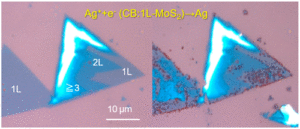
T. Taniguchi, L. Nurdiwijayanto, S. Li, H-E. Lim, Y. Miyata, X. Lu, R. Ma, D-M. Tang, S. Ueda, K. Tsukagoshi, T. Sasaki, M. Osada: “On/off boundary of photocatalytic activity between single- and bilayer MoS2”, ACS Nano, in press (2020).
Abstract
Molecularly thin two-dimensional (2D) semiconductors are emerging as photocatalysts owing to their layer-number-dependent quantum effects and high charge separation efficiency. However, the correlation among the dimensionality, crystallinity, and photocatalytic activity of such 2D nanomaterials remains unclear. Herein, a Ag photoreduction technique coupled with microscopic analyses is employed to spatially resolve the photocatalytic activity of MoS2 as a model catalyst. Interestingly, we find that only monolayer (1L)-MoS2 is active for a Ag photoreduction reaction. The photocatalytic activity of 1L-MoS2 is enhanced by a built-in electrical field originated from the MoS2/SiO2 interface, instead of by the specific surface structure and quantum electronic state of 1L-MoS2. Furthermore, we observe photocatalytic active sites to be geometrically distributed on triangular 1L-MoS2 crystals, wherein the Ag particles are preferentially deposited on the outermost zigzag edges and defective inner parts of the triangular grains. The degradation of photocatalytic activity and electron mobility with the formation of Mo(VI) species indicates that the species inhibit the in-plane diffusion of the photogenerated electrons to the reductive sites. The monolayer-selectivity, activation, and inactivation mechanisms, unveiled in this work, will offer future directions in designing 2D nanophotocatalysts.
